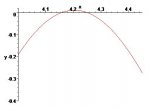Ok , so this equation has gave me a real headache.
\(\displaystyle 2cos^3x+sinx-3sin^2xcosx=0\)
I can't get anywhere near the solution.
I have already tried a multiplication with cos x and that got me nowhere :roll:
And I also tried to write
\(\displaystyle 3sin^2xcosx\)
as
\(\displaystyle 2sin^xcosx - sin^2xcosx\)
and got to \(\displaystyle 2cosxcos2x+sinxsin2x=0\) but I don't know if
it is right or how to continue from here.
Dose anybody have a clue how to resolve this?
Any help will be greatly appreciate .
\(\displaystyle 2cos^3x+sinx-3sin^2xcosx=0\)
I can't get anywhere near the solution.
I have already tried a multiplication with cos x and that got me nowhere :roll:
And I also tried to write
\(\displaystyle 3sin^2xcosx\)
as
\(\displaystyle 2sin^xcosx - sin^2xcosx\)
and got to \(\displaystyle 2cosxcos2x+sinxsin2x=0\) but I don't know if
it is right or how to continue from here.
Dose anybody have a clue how to resolve this?
Any help will be greatly appreciate .



